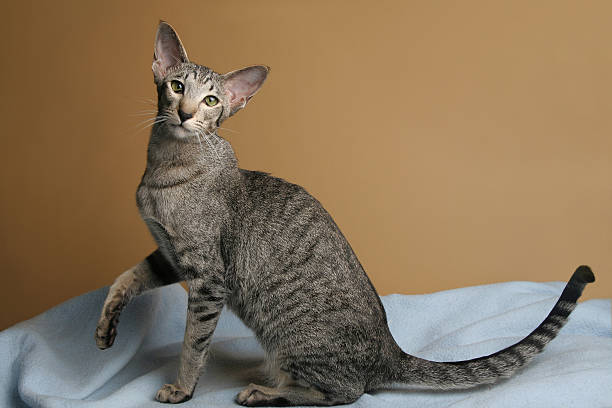Oriental Shorthair

History:
The Oriental Shorthair is a sleek and elegant breed developed in the 1950s and 1960s in the United Kingdom. It was created by crossing Siamese cats with other shorthaired breeds such as the Russian Blue, British Shorthair, and Abyssinian to introduce a wider variety of coat colours and patterns. Though it shares the Siamese body type and vocal personality, the Oriental Shorthair stands out with its large ears, almond-shaped eyes, and diverse coat colours—over 300 variations exist. This breed is known for its affectionate, intelligent, and social nature, often forming strong attachments with its owners. Energetic and curious, Oriental Shorthairs thrive on interaction and do best in active households.
Size: Medium-sized cat
Height: 20–25 cm
Weight: 3.5–5.5 kg
Life Expectancy: 12 to 15 years

Breed Appearance:
The Oriental Shorthair is a medium-sized cat with a sleek, slender, and fine-boned body that reflects its Siamese ancestry. It has long, graceful lines, a tubular torso, and long, slim legs, with the hind legs slightly longer than the front. Its short, fine coat lies close to the body and comes in an extraordinary range of colours and patterns—more than 300 combinations are recognised. The breed's most striking features include its large, pointed ears that sit upright and wide-set, and its almond-shaped eyes, usually a vivid green (except in white cats, which may have blue or odd-colored eyes).
The head is a long, tapering wedge with a straight profile, giving it an elegant, angular appearance. Oriental Shorthairs move with fluidity and are known for their agility and athleticism. Despite their lean build, they are muscular and strong, built for active play and graceful movement.
Health & Care:
The Oriental Shorthair is generally a healthy breed, but it may be prone to some genetic conditions shared with its Siamese relatives, including dental issues and, less commonly, liver or heart problems. Regular veterinary checkups help catch any concerns early. Their short, fine coat is low-maintenance and only needs occasional brushing to remove loose hair and keep it glossy. Routine dental hygiene, a balanced diet, and maintaining an active lifestyle are important for their overall health. Due to their social and energetic temperament, Oriental Shorthairs benefit greatly from daily play, mental stimulation, and plenty of human interaction to stay emotionally and physically fit.

Living Conditions:
Oriental Shorthairs adapt well to various home environments, from spacious houses to smaller apartments, as long as their need for attention and stimulation is met. They are highly social and thrive on companionship, often forming strong attachments with their owners and preferring not to be left alone for long periods. This breed gets along well with children, other cats, and friendly dogs, making them ideal for families or multi-pet households. Oriental Shorthairs enjoy warm, cosy spots, high perches, and interactive toys. Though quite vocal, their communication is expressive rather than disruptive. A stable routine and plenty of engagement help them feel secure and happy.
Grooming:
With their short, fine coat, Oriental Shorthairs are low-maintenance when it comes to grooming. A weekly brushing is usually enough to remove loose hair and keep their coat sleek and shiny. They shed moderately, so extra brushing during seasonal changes can help. Their grooming routine should also include regular dental care to prevent gum disease, along with nail trimming and ear cleaning as needed. While baths are rarely necessary, they can be given occasionally, especially if the cat becomes soiled. Overall, Oriental Shorthairs are easy to groom and maintain with basic, consistent care.

Advantages:
-
Oriental Shorthairs are affectionate, intelligent, and people-oriented cats that form strong emotional bonds with their owners, often becoming devoted companions who crave interaction.
-
Their short, sleek coat is easy to care for, requiring minimal grooming, making them a low-maintenance choice for busy households.
-
Highly intelligent and curious, they are quick learners and enjoy interactive play, training games, and puzzles that keep their active minds engaged.
-
Social and adaptable, they typically get along well with children, other cats, and even dogs, thriving in multi-pet households where they aren’t left alone for extended periods.
-
Expressive and communicative, they “talk” frequently with their humans, which many owners find endearing and entertaining in an engaging household companion.
Disadvantages:
-
Their intense need for attention and companionship can make them prone to separation anxiety if left alone for long hours, potentially leading to destructive behavior or stress.
-
Their vocal nature may not suit quiet households, as they can be quite chatty and persistent in expressing their needs or emotions.
-
Oriental Shorthairs are extremely active and require significant physical and mental stimulation; without it, they may become bored or mischievous.
-
Though generally healthy, they may inherit genetic issues from their Siamese lineage, including dental problems and certain organ-related conditions that need regular monitoring.

